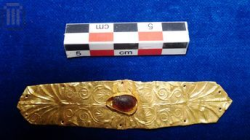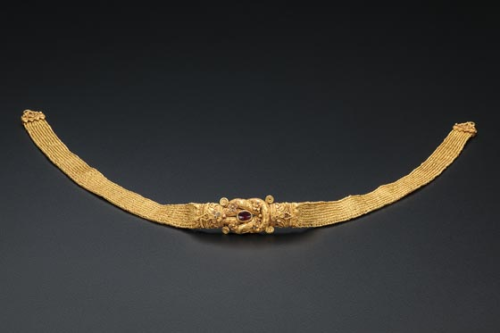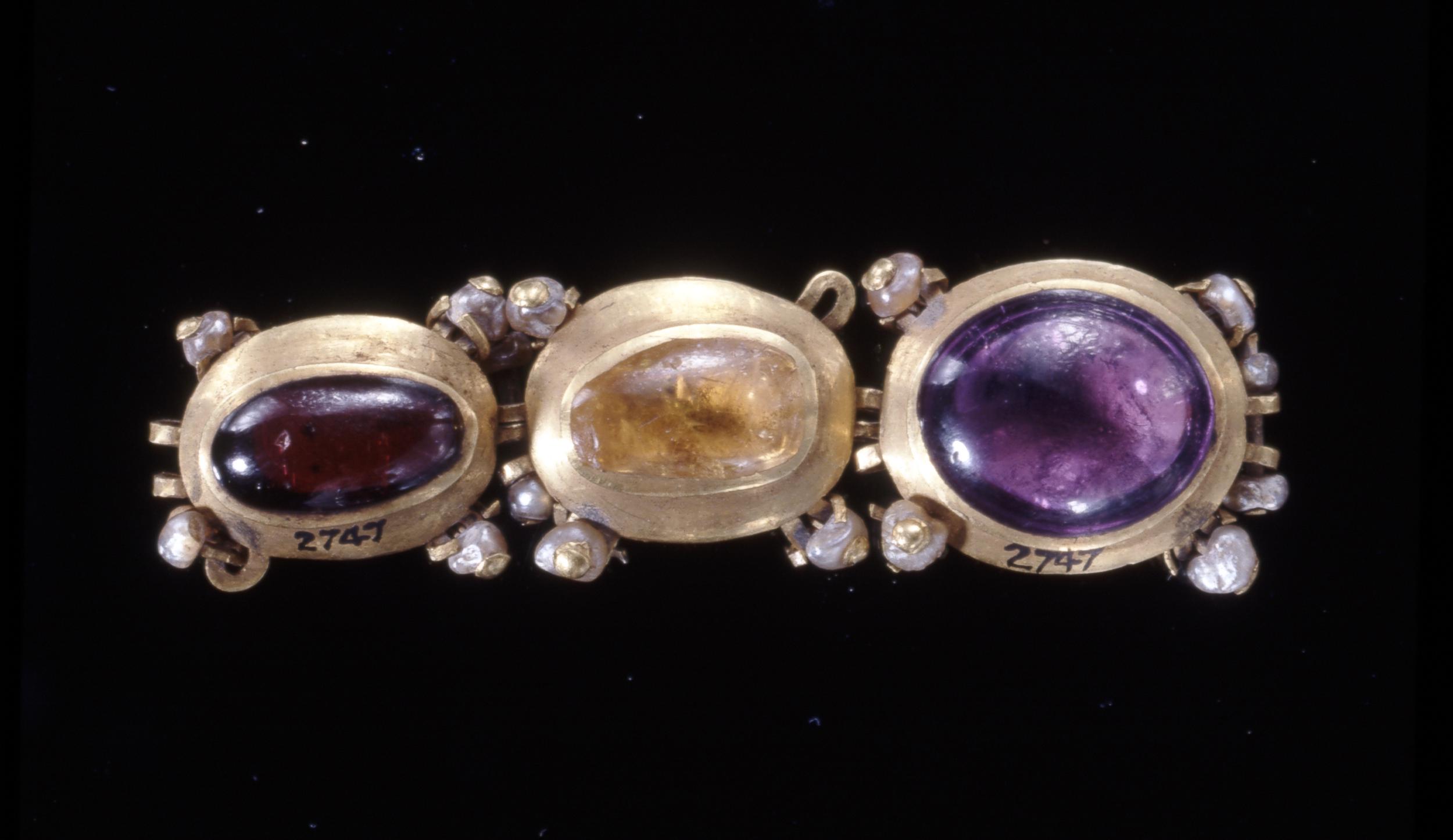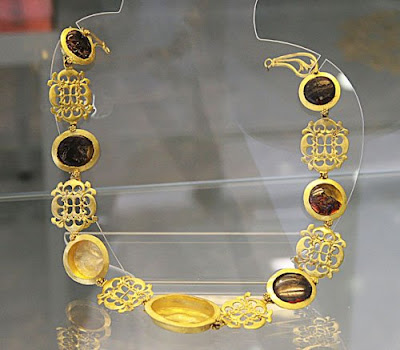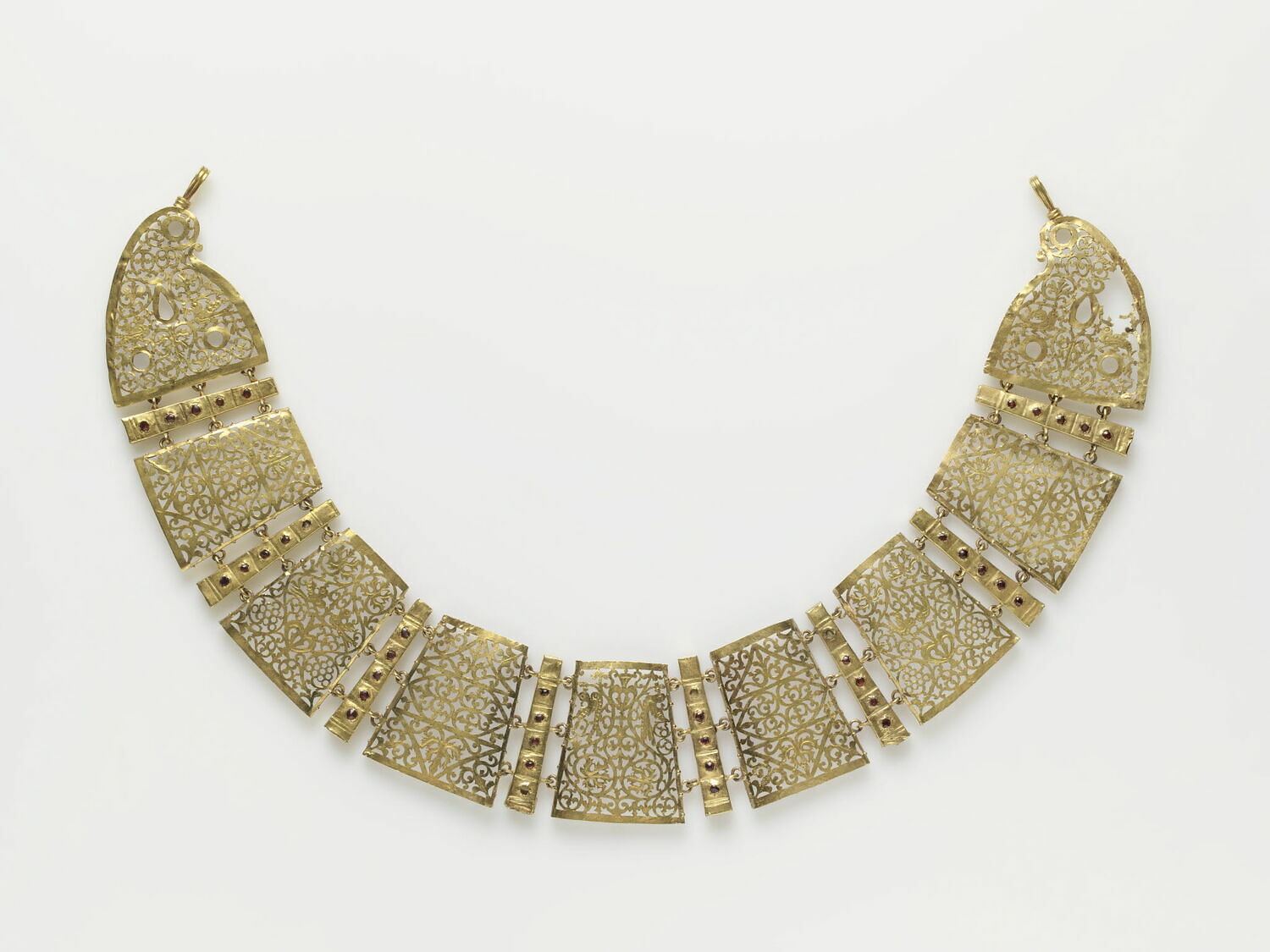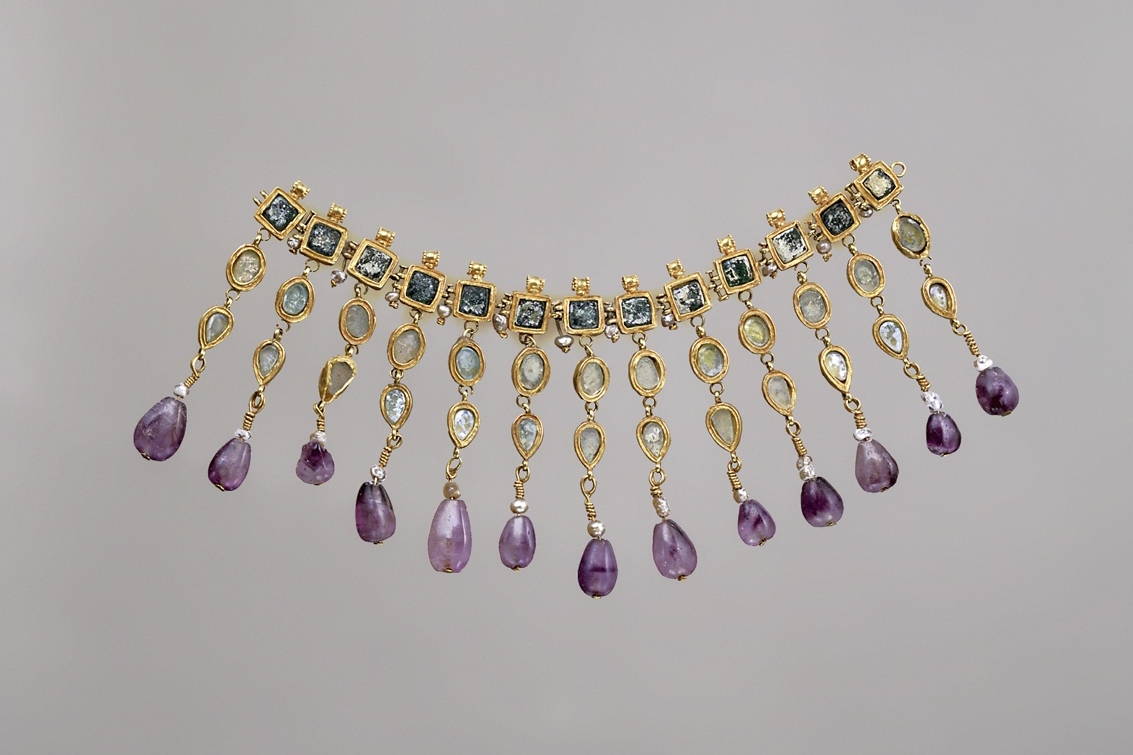In this section are Hellenistic diadems in the form of a headband, the headdress that required additional lacing at the back to be worn.
Segmented diadems
2nd century BCE, gold with garnets, a diadem with pendants
read more>>
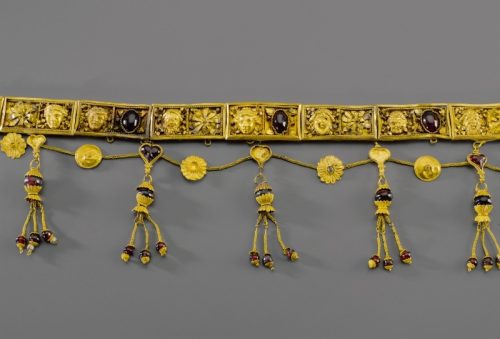
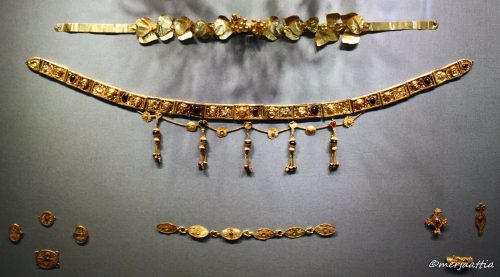
To compare:

See also >>
Necklace / diadem, gold, blue glass paste; 3rd century BCE.
Found: Panticapaeum. Crimea, the environs of Kerch
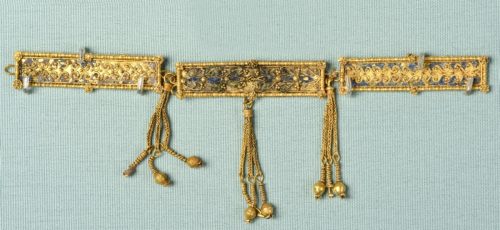


https://colorsandstones.eu/2023/07/06/amisos-treasure/
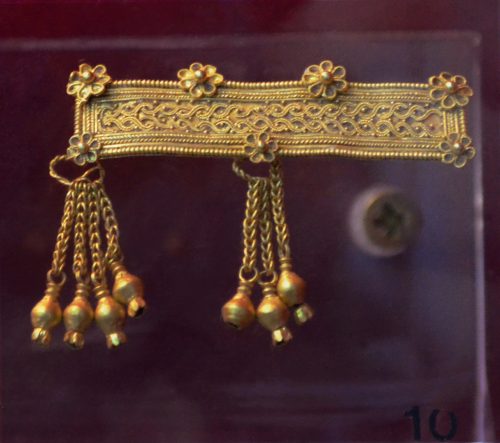
Archaeological Museum of Lamia, ca 5th C BCE source
“Four rectangular parallelogram-shaped lamination tiles that would be attached to a garment. The main face is decorated with a stem spiracle of epithet, attached to the lamina with very fine wire. The central subject is framed by three rows of twisted wire, glued to the lamina, running across the surface parallel to the sides of the tile. The corners of the tile are decorated with a diagonally placed anthemion petal. At the ends of one long side it has two rings, while on the back and along the other long side it has three double loops.” https://nationalarchive.culture.gr
L. 3.2 cm
“Gold [Hellenistic] jewellery from the Thebes Railway Station hoard. Four sewn-on pieces, a pair of earrings with pendent cupids riding garnet dolphins, a necklace with heads of griffin-lions on the finial clasp, and a Heracles’ knot from a necklace.”
[Archaeological Museum of Thebes catalog,
John S. Latsis Public Benefit Foundation and EFG Eurobank Ergasias S.A., 2010, pp. 333-334]
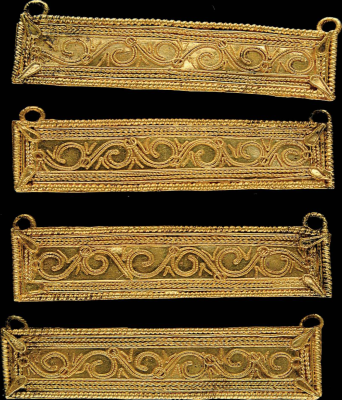
Compare with the elements of a diadem from Mesambria, 3rd century BCE
Cross-strap diadem
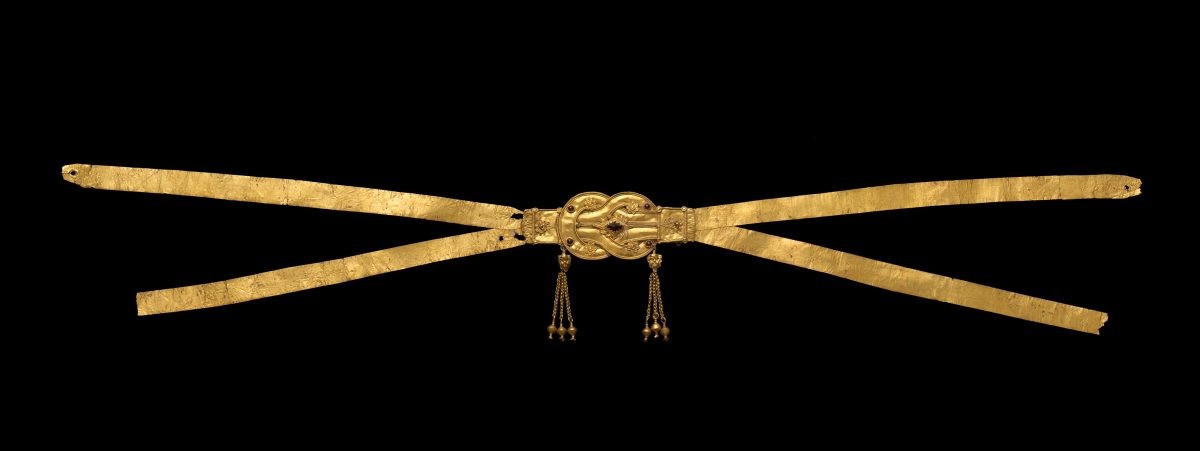
Greek / Hellenistic 300-250 BCE, diadem with pendants, gold and garnets.
Dimensions: width [length] as mounted 42.5 cm
total H. as mounted 7 cm
length of straps 19 cm
H. of Herakles knot 2.7 cm
“Gold cross-strap diadem with a central Herakles knot decorated with filigree spirals and globules; the straps are decorated with figures of Erotes with wine-amphorae and musical instruments, separated by wine-amphorae or flaming torches.”
Ca 250 BCE
Length: 22.10 cm (each ribbon)
Length: 2.50 cm (knot)
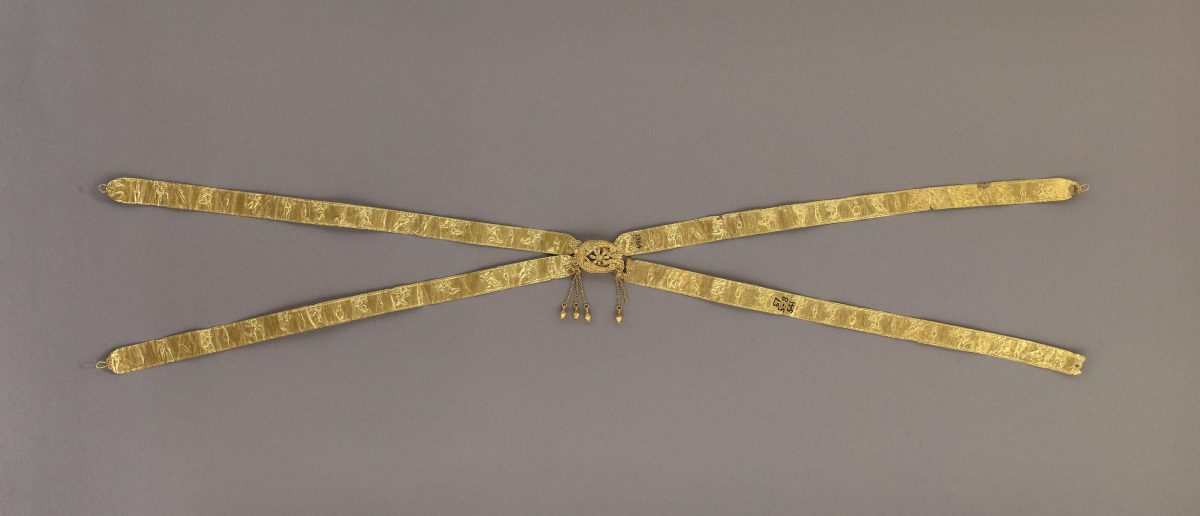
1867,0508.541
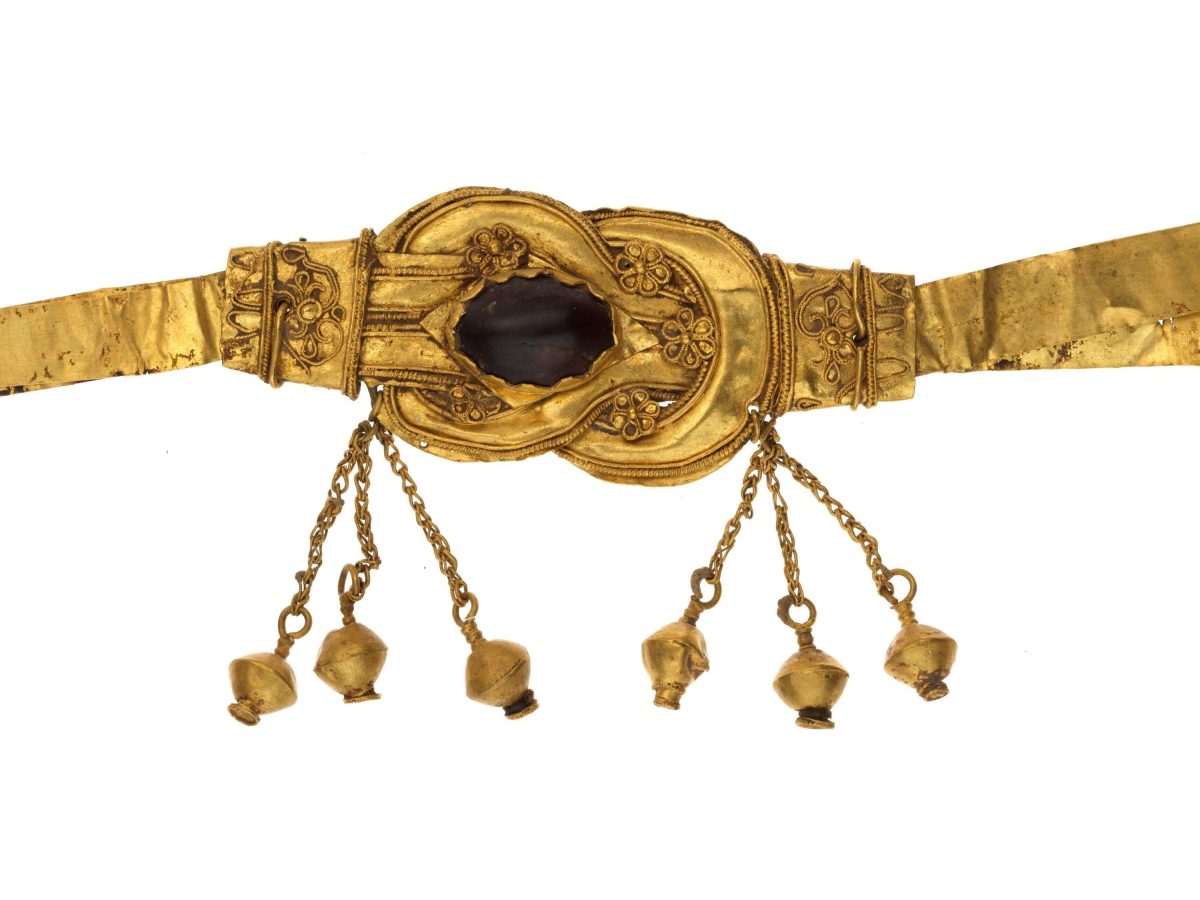
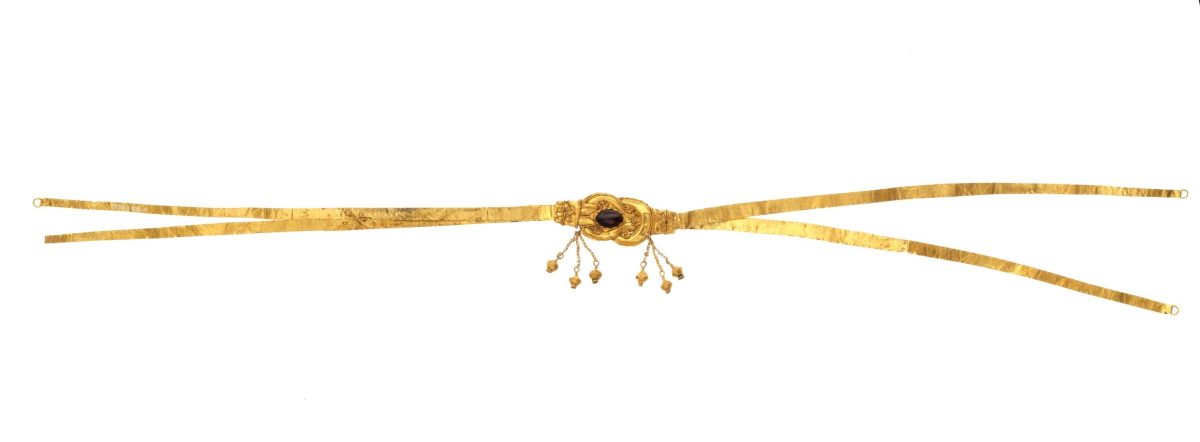
Cross-strap diadem with a Herakles knot; gold, garnet.
Greek, Eastern Mediterranean; about 325-250 BCE
Length: 50.1 cm
“The centerpiece of the diadem is a Herakles knot with its edges defined by beaded wire and surface decorated with five, six petalled filigree rosettes. It is set with a garnet cabochon and flanked by two pairs of sheet gold ribbons; a small attachment loop is fitted to the end of each ribbon. A group of three pomegranate pendants on short chains is suspended on either side of the knot. Surfaces of the rectangular-shaped terminals on either side of the knot are decorated with beaded wire, filigree floral motifs and tongues.”

Diadem with gemstones, “Hellenistic-Roman”, 1st century BCE-1st century CE.
Gold foil. It has ten holes for sewing it on luxurious fabric or tape. At center, carnelian framed by printed floral decoration.
Width : 2.3 cm. Length : 9.3 cm.
301 BC – 251 BC, Archaeological Site of Ancient Elis [ Ilia]
Collection of the Museum of Elis, Greece
Ηλεκτρονικός Κατάλογος Περιγραφών Εκθεμάτων Μουσείου Ήλιδας : Δ3502, Ευρετήριο Ευρημάτων Ήλιδας 4 : Δ3502
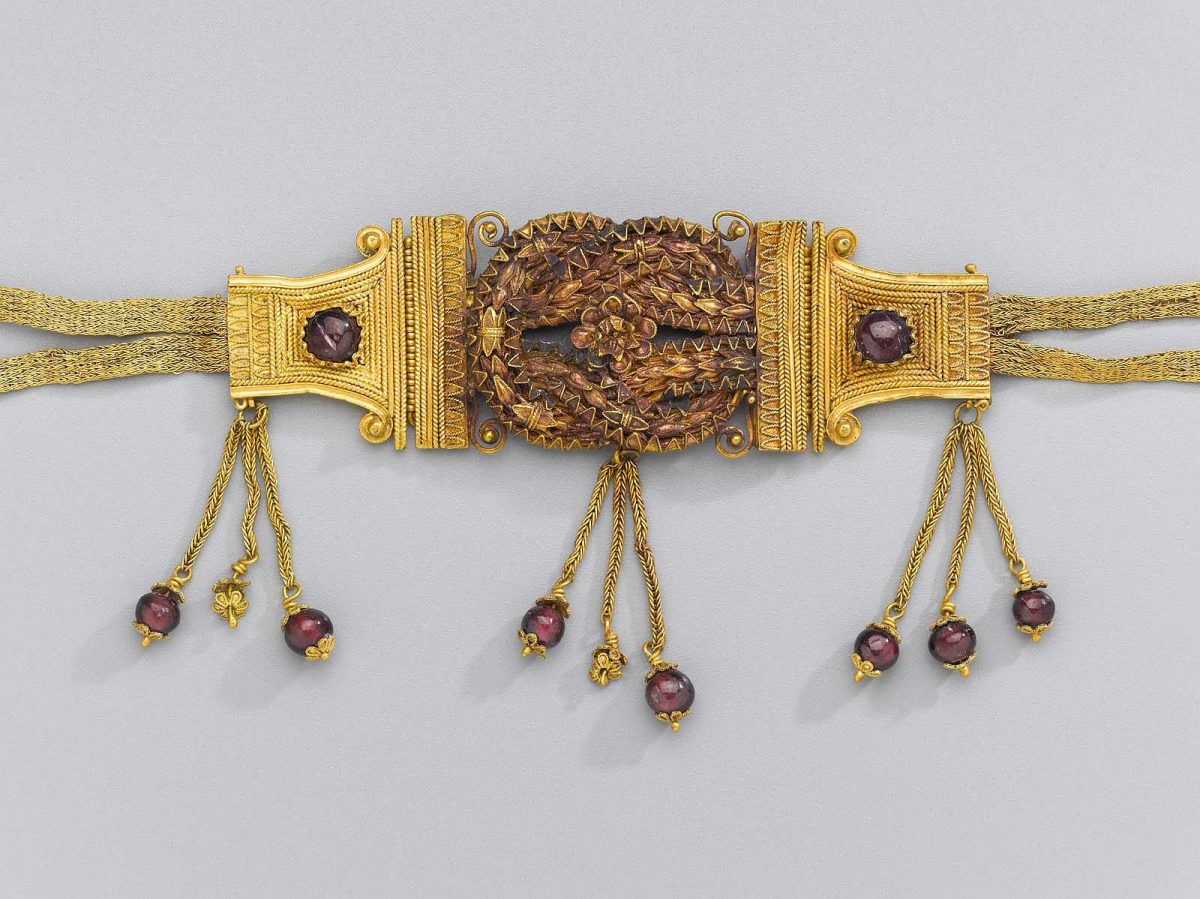
Diadem with pendants, Greek, Hellenistic, 200–150 BCE Gold and garnet, 47.5 x 5.5 x 0.6 cm.
“A diadem (or headband) worn over a high female coiffure. The center is composed of a Herakles knot, whose strands are garlands of pointed leavees; a rosette, once inlaid with a stone, marks the center of the knot.”
From the Thessaly/Karpenisi treasure, Benaki Museum
early 2nd century BCE
“Precious gold diadem and diadem centrepiece with a ‘Herakles Knot’ and garnet, agate, enamel and glass paste ornaments. Diadems of this type were worn on a high coiffure with the pendent elements falling on the forehead. The ‘Herakles Knot’, to which protective and therapeutic qualities were attributed, was widely used in Hellenistic and Roman jewellery. Early 2nd c. BC. L. 0.51 m. (ΓΕ 1549)”
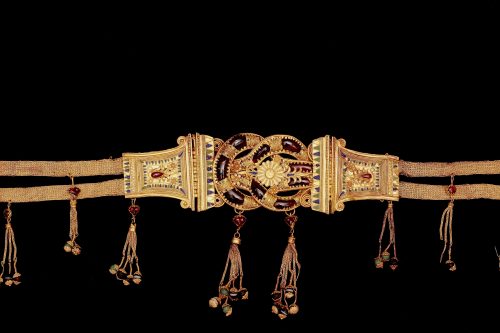
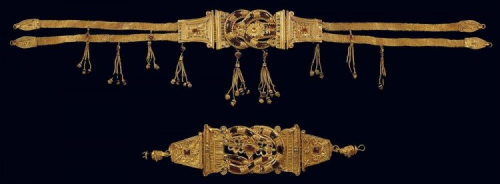
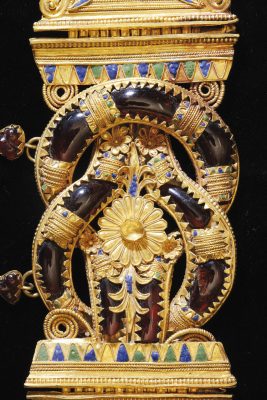
Strap diadem
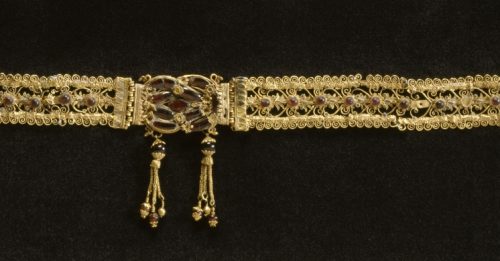

3rd-2nd century BCE (Hellenistic), Greece, Macedonia (Place of Discovery).
Gold, garnet, enamel, dimensions: 45.09 × 6.1 × 0.7 cm
To compare:
Etruscan headband, 6th-5th century BCE, St. Louis Art Museum collection [read more]

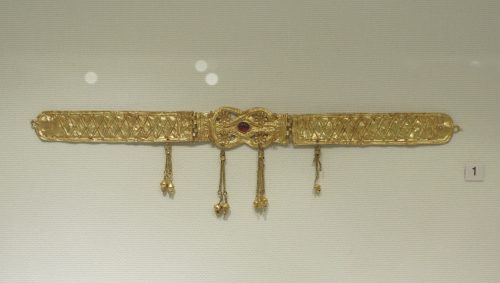
Photo ©George E. Koronaios
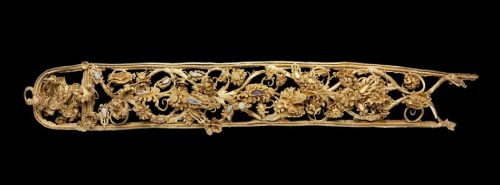
Vine-trellis diadem, Greek, Hellenistic, late 4th–early 3rd century BCE. Findspot: Greece, Euboia, Eretria, Tomb of the Erotes. Gold with glass paste and carnelian; 2.5 x 18.5 cm.
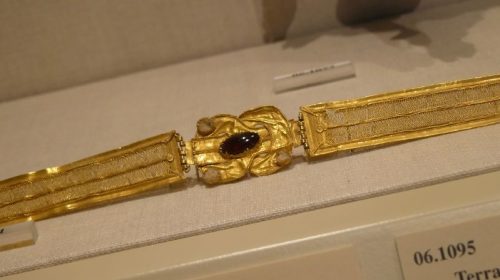
Gold and garnet strap diadem with Herakles knot, 3rd-2nd century BCE.
20.6 cm
The Met 20.241
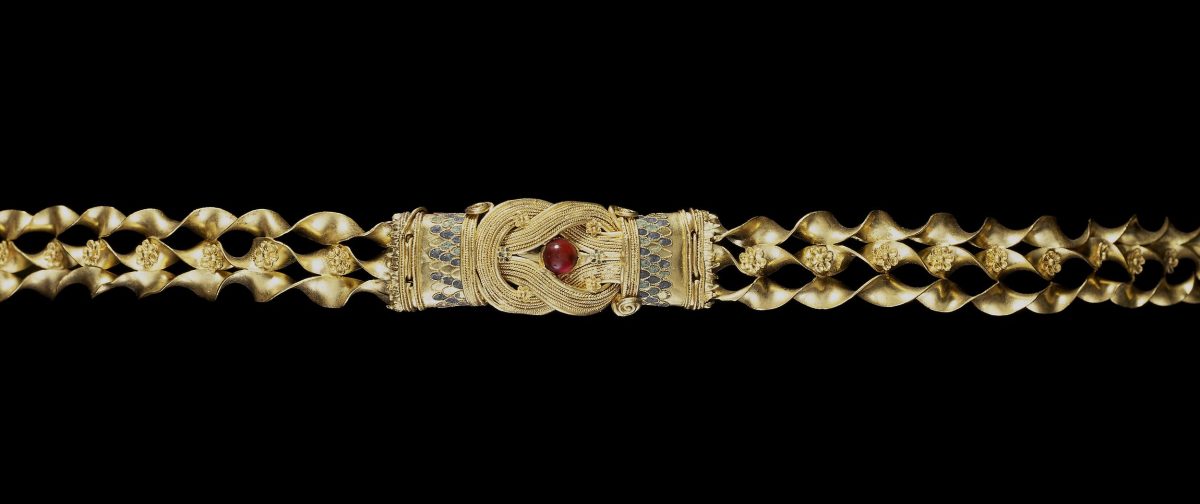
1872,0604.815
Gold diadem of twisted ribbons with a Herakles knot; gold, garnet, enamel. Said to be from Melos.
Length: 27.90 cm
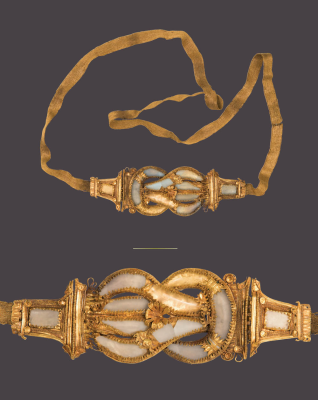
Diadem or a body decoration.
This jewel retains the form of a strap diadem, but due to the length of the strap and the clasp hidden by the central ornament, it is considered a decoration of the body.
Gold and glass, possibly from Thessaly, late 3rd-early 2nd century BCE. NAM Athens collection, from the so-called “Karpenisi Treasure”.
literature:
The National Archaeological Museum of Athens catalogue, Latsis 2007
D. Ignatiadou – A. Chatzipanagiotou, “Jewellery uses and symbolism, from the Geometric to Roman period”, in M.Lagogianni-Georgakarakos
Greek, Diadem. Gold, garnet, and blue glass enamel inlay, about 250–150 BCE. 14 ½ inches. Gift of The Apollo Society with additional funds from the Libbey Endowment, Gift of Edward Drummond Libbey, 2005.45.
“This diadem was made in seven parts. The two straps each have three components: the terminal with loop, the chain strap, and the floral cuff. The central knot was fabricated from gold sheet, wire, granules, and inlays that were fused together. The parts were then joined using links, rivets, and wires.”
The Toledo Museum brochure https://itunesu-assets.itunes.apple.com

First half of the 3rd century BCE. Messambria, Bulgaria
Read more >> https://colorsandstones.eu/2023/05/06/messambria/

5411. © ΥΠΟΥΡΓΕΙΟ ΠΟΛΙΤΙΣΜΟΥ & ΑΘΛΗΤΙΣΜΟΥ. ΤΑΜΕΙΟ ΑΡΧΑΕΟΛΟΓΙΚΩΝ ΠΟΡΩΝ.
Source: Journal of Greek Archaeology, 2017 vol. 2
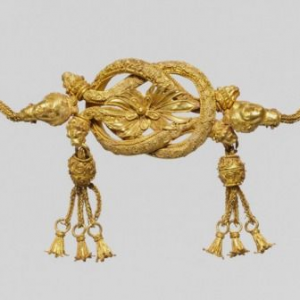
late 4th–3rd century B.C.E.
In the Met inv. no. 1995.539.7
“The central ornament of the fillet is a Herakles knot. Two palmettes with a rosette in the middle fill the center of the knot, while the four ends terminate in lion heads. Between the pairs of lion heads on the knot are two exquisitely finished female heads. At the clasp end of the chains are lion-head terminals, each with a ring in its mouth.”
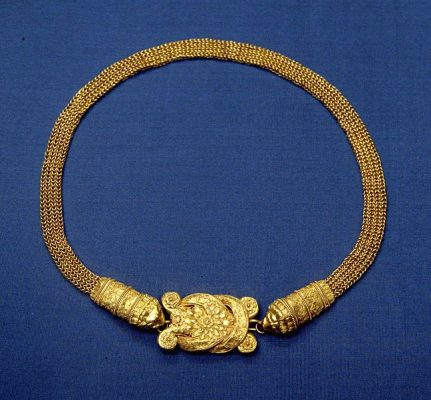
Photo ©Bibi Saint-Pol
More diadems / necklaces of this type
https://collections.louvre.fr/en/ark:/53355/cl010433604
https://collections.louvre.fr/en/ark:/53355/cl010433603
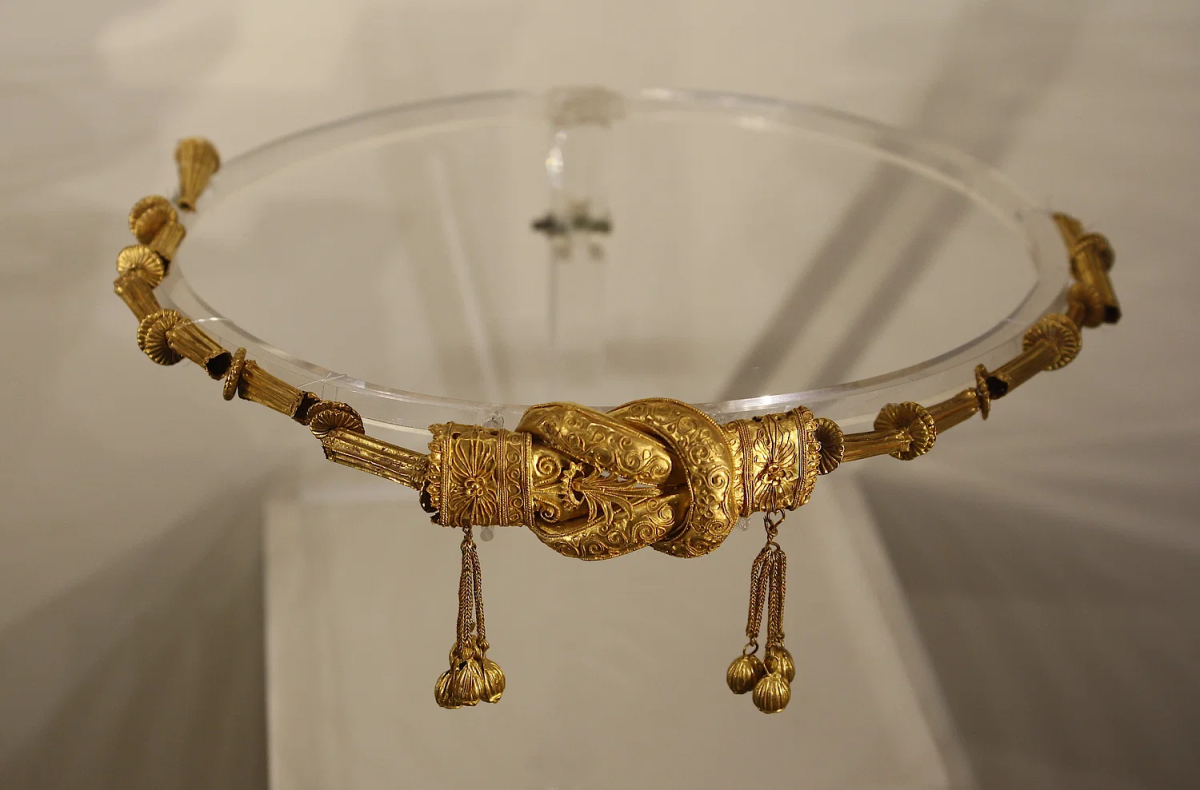
Photo ©Mark Cartwright https://www.worldhistory.org
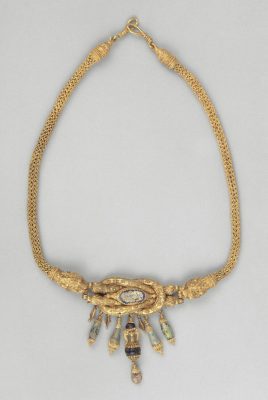
© 2021 GrandPalaisRmn
Musée du Louvre, Bj 2348 https://collections.louvre.fr

The website of this diadem does not exist anymore.
Hellenistic diadem with Pegasus and palmette motif. Made of gold with a glass cabochon, is 29 cm long. The wide strap is made of 8 connected loop-in-loop chains.
4th – 3rd century BCE, from the Platar Collection, Ukraine


Diadem with ornamental frieze, Greek / Hellenistic, 4th century BCE. Gold, diam. 8.89 × diam. 8.89 × width 3.49 cm

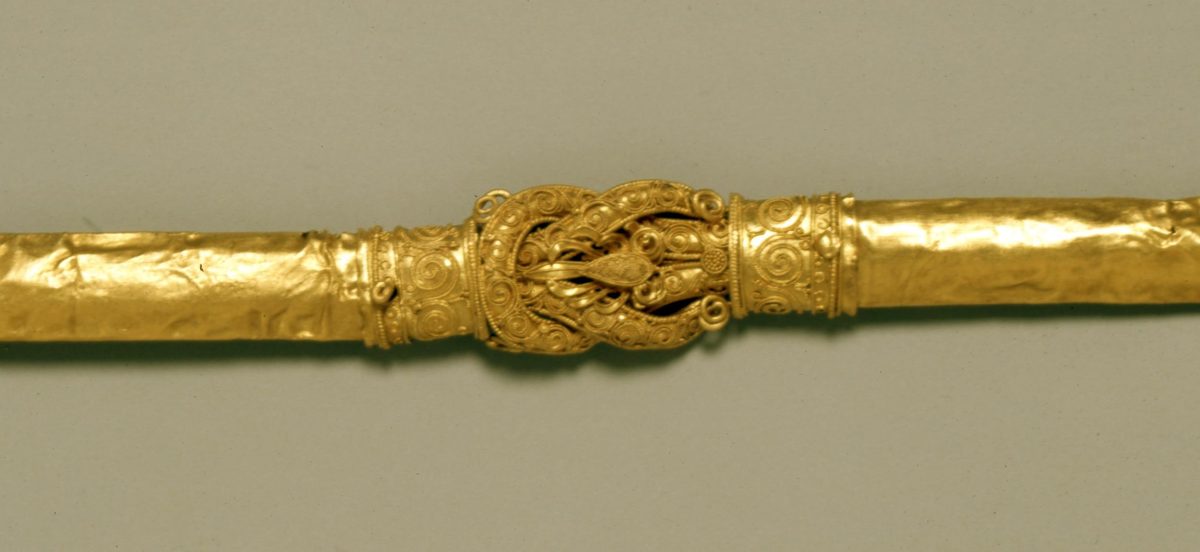
1905,1025.1
“Gold diadem with a central Herakles knot decorated with filigree wire and minute granulation.”
330-300 BCE, said to be from Crimea
Length: 23.50 cm
- Hellenistic Gold Diadems – Form, Function and Meaning – Ch IV & Ch V, https://www.academia.edu
- Archaeological Museum of Thebes catalog,
John S. Latsis Public Benefit Foundation and EFG Eurobank Ergasias S.A., 2010 - The National Archaeological Museum of Athens catalogue, Latsis 2007
- D. Ignatiadou – A. Chatzipanagiotou, “Jewellery uses and symbolism, from the Geometric to Roman period”, in M.Lagogianni-Georgakarakos (ed.), The Countless Aspects of Beauty in Ancient Art, Catalogue of an Exhibition, Athens 2018, 265-281 https://www.academia.edu

